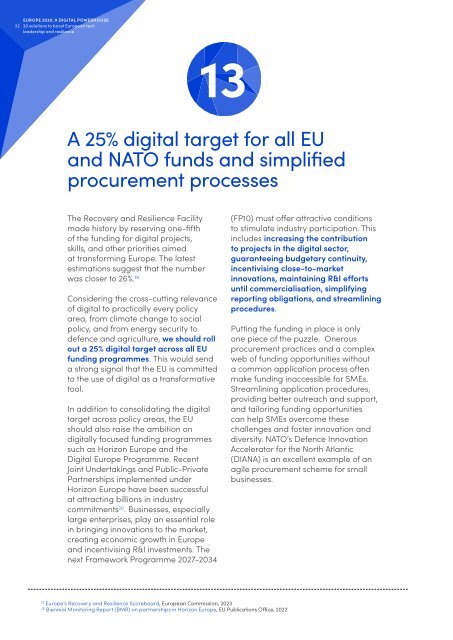DIGITALEUROPE - EUROPE 2030 A DIGITAL POWERHOUSE FINAL WEB_PBP
Create successful ePaper yourself
Turn your PDF publications into a flip-book with our unique Google optimized e-Paper software.
32<br />
<strong>EUROPE</strong> <strong>2030</strong>: A <strong>DIGITAL</strong> <strong>POWERHOUSE</strong><br />
20 solutions to boost European tech<br />
leadership and resilience<br />
13<br />
A 25% digital target for all EU<br />
and NATO funds and simplified<br />
procurement processes<br />
The Recovery and Resilience Facility<br />
made history by reserving one-fifth<br />
of the funding for digital projects,<br />
skills, and other priorities aimed<br />
at transforming Europe. The latest<br />
estimations suggest that the number<br />
was closer to 26%. 19<br />
Considering the cross-cutting relevance<br />
of digital to practically every policy<br />
area, from climate change to social<br />
policy, and from energy security to<br />
defence and agriculture, we should roll<br />
out a 25% digital target across all EU<br />
funding programmes. This would send<br />
a strong signal that the EU is committed<br />
to the use of digital as a transformative<br />
tool.<br />
In addition to consolidating the digital<br />
target across policy areas, the EU<br />
should also raise the ambition on<br />
digitally focused funding programmes<br />
such as Horizon Europe and the<br />
Digital Europe Programme. Recent<br />
Joint Undertakings and Public-Private<br />
Partnerships implemented under<br />
Horizon Europe have been successful<br />
at attracting billions in industry<br />
commitments 20 . Businesses, especially<br />
large enterprises, play an essential role<br />
in bringing innovations to the market,<br />
creating economic growth in Europe<br />
and incentivising R&I investments. The<br />
next Framework Programme 2027-2034<br />
(FP10) must offer attractive conditions<br />
to stimulate industry participation. This<br />
includes increasing the contribution<br />
to projects in the digital sector,<br />
guaranteeing budgetary continuity,<br />
incentivising close-to-market<br />
innovations, maintaining R&I efforts<br />
until commercialisation, simplifying<br />
reporting obligations, and streamlining<br />
procedures.<br />
Putting the funding in place is only<br />
one piece of the puzzle. Onerous<br />
procurement practices and a complex<br />
web of funding opportunities without<br />
a common application process often<br />
make funding inaccessible for SMEs.<br />
Streamlining application procedures,<br />
providing better outreach and support,<br />
and tailoring funding opportunities<br />
can help SMEs overcome these<br />
challenges and foster innovation and<br />
diversity. NATO’s Defence Innovation<br />
Accelerator for the North Atlantic<br />
(DIANA) is an excellent example of an<br />
agile procurement scheme for small<br />
businesses.<br />
19<br />
Europe’s Recovery and Resilience Scoreboard, European Commission, 2023<br />
20<br />
Biennial Monitoring Report (BMR) on partnerships in Horizon Europe, EU Publications Office, 2022



